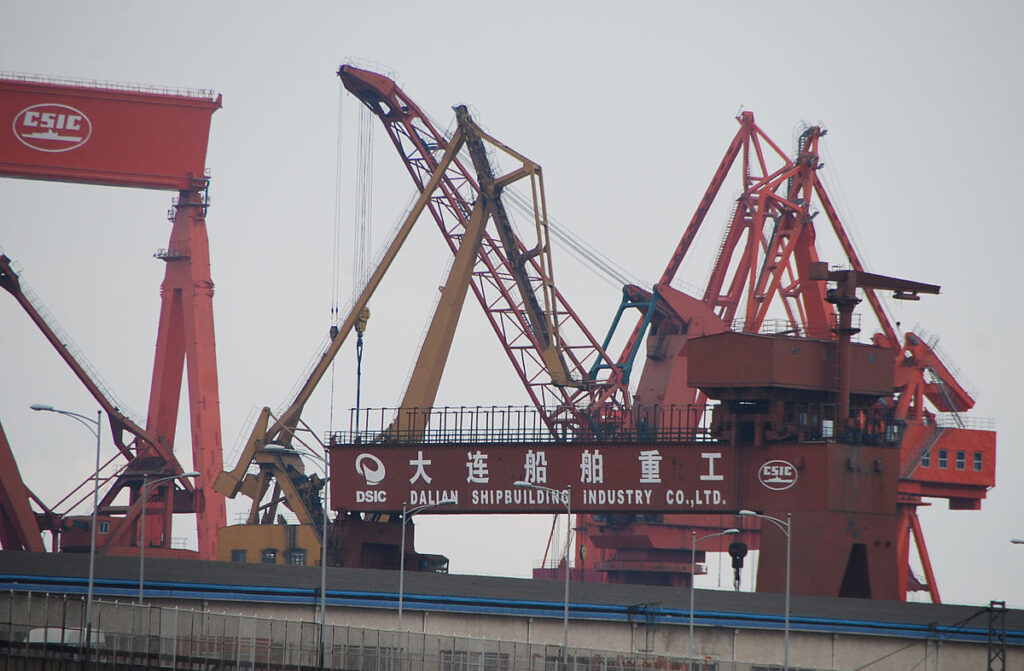(Series No. 375) Chinese Shipbuilding: Reviving the Eliminated Group. Tokushima Shipowners Aim to Enter the Ocean-going Vessel Market.”
“Visiting Chinese shipyards, I was astonished by their remarkable progress.”
Despite the ongoing heatwave in central Tokyo, a maritime industry professional who had just returned from a tour of Chinese shipyards spoke with invigorated enthusiasm.
■China’s “Shipbuilding Ginza”
Chinese shipyards were once criticized for offering low-cost ships with quality concerns. Indeed, before the Lehman Brothers collapse in 2008, during the shipping boom, several so-called shipyards existed, claiming they would take orders for new ships even before the yards were fully constructed.
These shipyards were expected to be weeded out by the Lehman shock—or so it seemed.
The expert continued, “Private shipyards have made a remarkable comeback. Large-scale yards are sprawling across vast lands. Due to the intense daytime heat, work is concentrated from early morning to noon.”
Photo courtesy =Wikipedia, CSSC Dalian Ship building industry

Japan’s shipyards face a labor shortage, a challenge not mirrored in China.
Another industry insider added, “Due to the real estate slump in China, many workers are moving to shipyards. A director of a Chinese shipyard mentioned that while Japanese shipyards might employ 2,000 workers, they can deploy 5,000. As a result, the delivery times for new ships are ahead of schedule.”
The threat of Chinese shipyards is a concern that has been whispered in Japan’s maritime and shipbuilding industries for years.
The issue lies in the “temperature gap” between those who have visited the sites and those who rely on second-hand information in Japan.
A company shipping division executive remarked, “It’s essential to see it for yourself. There’s no denying that Chinese shipyards are a key factor in the global maritime and shipbuilding industries.”
This isn’t to say Chinese shipyards don’t face challenges. Engine supply has become a bottleneck, leading to fierce competition in the shipbuilding market. Even if Chinese engine manufacturers start licensed production immediately, assessing their quality is crucial.
Nonetheless, as the maritime expert initially mentioned, “The global shipping brokers’ focus on Chinese shipyards is unavoidable. While both Japanese and Chinese shipyards are booked until 2028, it’s noteworthy how many Chinese shipyards are building medium-sized bulk carriers, a traditional strength of Japanese yards.”
Workshop on Ocean-Going Vessels Held
On July 29, about a 15-minute taxi ride from central Tokushima City, the Tokushima Taisho Bank Training Center hosted a gathering of 32 participants from 15 shipping companies and related organizations in Tokushima.
“Currently, we focus mainly on domestic shipping, but we want to expand into ocean-going vessels in the future. I joined this workshop hoping to gain some valuable insights,” said a Tokushima shipowner.
On this day, Tokushima Taisho Bank organized a workshop on ocean-going vessels, inviting Lightship, a provider of digital shipping platforms, and maritime specialist media to discuss risk management and the current state of ocean shipping.
Lightship originally started as an initiative by a major Australian resource company to prevent port accidents and reduce vessel delays. Since 2020, it has evolved into a platform that provides vessel data to a wide range of shipping operators.
However, for shipowners, Lightship’s scores still have significant practical implications. A low score can result in exclusion by operators and restrictions on the regions where vessels can dock.
Yu Yamada, Assistant Director at Lightship, explained, “For example, even if accidents or incidents occur, if their severity and frequency are lower compared to other vessels or management companies, the score will trend upwards. Additionally, if a vessel receives fewer deficiencies or issues during PSC (Port State Control) inspections compared to the past average at that port, the score will not decrease but rather improve.”
In response, several shipowners expressed candid opinions, asking, “How can we improve our Lightship scores? Should we contract with Lightship?”
Mr. Yamada emphasized that the current digital platform for vessels ensures transparency and eliminates arbitrariness.
In ocean shipping, geopolitical risks are increasing in addition to the traditional substandard ships that fail to meet international treaty standards.
Especially when domestic shipowners venture into ocean shipping, they often start with “BBC” (bareboat charter) operations where they do not manage the ships themselves. In such cases, if their vessels are deployed to conflict zones like the Red Sea or the Black Sea, the shipowners and financial institutions have no choice but to negotiate with the operators.
Of course, the participating shipowners are experts in both domestic and international shipping. With a deep understanding of these circumstances, they will consider expanding into ocean shipping.
Tokushima Taisho Bank, through these workshops, aims to share risks with the shipowners and stated, “We will continue to support Tokushima shipowners in their efforts to venture into ocean-going vessels.”
(Domestic Shipowners Editorial Team)
【国内船主の今】日本船主、日本造船、地方銀行、商社の動向に迫る連載シリーズ
(375)中国造船 淘汰組が復活。外航船への進出目指す徳島船主
私は中国の造船所を視察に行き、その発展ぶりに目からうろこが落ちる思いがした。
酷暑が続く東京都心のオフィス。中国造船所の視察から帰ってきた海運関係者が疲れも見せず力強く語った。
■中国の〝造船銀座〟
かつて中国造船所は「船価は安いが品質の面で不安がある」という指摘が多かった。
実際、2008年のリーマン・ショック以前、海運ブーム期には「これから更地に造船所を建設するので、とりあえず新造船の受注を受けている」という自称造船所も複数存在した。
そうした中国造船所はリーマン・ショックにより淘汰(とうた)された―はずだった。
前記の海運関係者が続ける。
「民営造船所を中心に見事に復活してきた。広大な土地一体に大型ヤードが乱立している。日中の気温が一定に達すると作業が中止されるため、早朝から正午にかけ、集中的に作業が行われていた」
日本造船所の人手不足もどこ吹く風のようだ。
同席した別の海運関係者が話す。
「中国は不動産不況で労働者が造船所に流れている。ある中国の造船所の所長は日本の造船所が2000人の作業員ならわれわれは5000人を投入できると話した。実際、新造船の納期が前倒しされている」
中国造船所の脅威―。
日本の海運、造船業界でも数年前からささやかれてきたことだ。
問題は、実際に現地を視察した人間と日本で中国情報を得ている関係者の間に「温度差」があることだ。
商社船舶部OBが語る。
「実際に現地に行くことが必要だ。中国造船所が世界の海運、造船業界のキーファクターであることは間違いない」
中国造船所に課題がないわけではない。エンジンの供給がボトルネックになり、造船市場で争奪戦になっている。中国のエンジンメーカーがすぐにライセンス生産に取り組んでも品質について見極める必要がある。
それでも、と冒頭の海運関係者が話す。
「世界の海運ブローカーの目が中国造船所に向いていることは避けようがない。28年まで船台が埋まっているのは日本造船所と同じだが、日本造船所が得意としてきた中型バルカー建造を手掛ける中国造船所が多いことは注目せざるを得ない」
